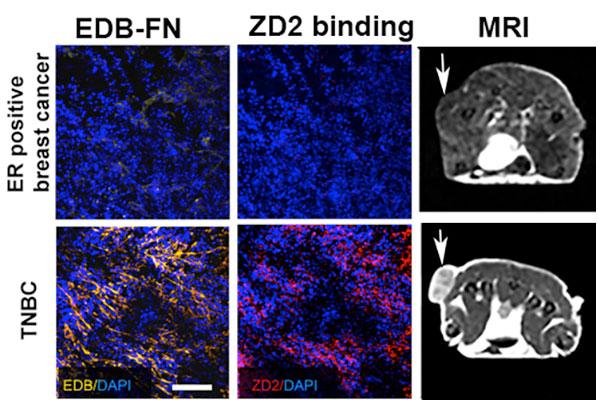MRI contrast agent locates and distinguishes aggressive from slow-growing breast cancer

The figure shows the different expression of the biomarker (EDB-FN) and probe binding (ZD2) in slow-growing ER-positive breast cancer (not much yellow and red color representing low expression of the biomarker and low binding), and in triple- negative breast cancer (TNBC, high expression and high binding). As a result, the targeted contrast agent produced weak signal enhancement (brightness) in the former and strong signal (brightness) in the latter as pointed by the arrow. The technology is able to provide accurate detection and risk-stratification of aggressive BC. Credit: Case Western Reserve University
A new magnetic resonance imaging (MRI) contrast agent being tested by researchers at Case Western Reserve University not only pinpoints breast cancers at early stages but differentiates between aggressive and slow-growing types.
“Doing both will help doctors find the right treatment,” said Zheng-Rong Lu, the M. Frank Rudy and Margaret Dormiter Rudy Professor of Biomedical Engineering at Case Western Reserve and leader of the research. “There's no such technology available now that we know of.”
The gadolinium-based agent is also more efficient and safer than traditional agents, requiring a gadolinium dose 20-times smaller, easily flushing from the body and leaving no accumulation in tissues, the researchers found in tests with mouse models.
At the low dosage, the agent lights up cancer biomarkers during scans, overcoming the low sensitivity of MRI's for imaging the markers. The research was published today (Sept. 25) in Nature Communications.
To make the agent, Lu and colleagues at Case Western Reserve combined commercially available tri-gadolinium nitride metallofullerene (Gd3N@C80), a highly efficient contrast agent, with a peptide labeled ZD2, which was developed in Lu's lab.
Compared to the gadolinium used in traditional agents, Gd3N@C80's “structure is different–the gadolinium ions are encaged in a hollow molecule of fullerene that looks like a soccer ball,” Lu said. “The cage prevents direct contact between the gadolinium and tissue, and the gadolinium will not be released, which prevents any kind of interaction with tissue.”
“But the key technology for our targeted contrast agent is the peptide attached,” Lu said.
The lab applies ZD2 to the surface of the soccer ball. The peptide specifically targets the cancer protein extradomain-B fibronectin (EDB-FN). EDB-FN, which is associated with tumor invasion, metastasis and drug resistance, is highly expressed in the matrix around cancerous cells in many aggressive forms of human cancers.
In testing on six mouse models, MRI's detected breast cancers in all cases. But the signal created by the accumulation of contrast molecules on three aggressive triple-negative breast cancers (MDA-MB-231, Hs578T and BT549) were significantly brighter. Because slow-moving ER-positive breast cancers (MCF-7, ZR-75-1 and T47D) produce less EDB-FN, fewer molecules attached. While detectible, the signal was muted.
Coauthors of the study are biomedical engineering PhD students Zheng Han and Xiaohui Wu, research assistant Sarah Roelle and undergraduate student Chuheng Chen; and William Schiemann, the Goodman-Blum Professor of Cancer Research at the Case Comprehensive Cancer Center.
Lu's lab is now investigating ways to reduce the cost of producing the agent to make it more attractive for clinical use.
###
Case Western Reserve University is one of the country's leading private research institutions. Located in Cleveland, we offer a unique combination of forward-thinking educational opportunities in an inspiring cultural setting. Our leading-edge faculty engage in teaching and research in a collaborative, hands-on environment. Our nationally recognized programs include arts and sciences, dental medicine, engineering, law, management, medicine, nursing and social work. About 5,100 undergraduate and 6,200 graduate students comprise our student body. Visit case.edu to see how Case Western Reserve thinks beyond the possible.
Media Contact
All latest news from the category: Health and Medicine
This subject area encompasses research and studies in the field of human medicine.
Among the wide-ranging list of topics covered here are anesthesiology, anatomy, surgery, human genetics, hygiene and environmental medicine, internal medicine, neurology, pharmacology, physiology, urology and dental medicine.
Newest articles

A ‘language’ for ML models to predict nanopore properties
A large number of 2D materials like graphene can have nanopores – small holes formed by missing atoms through which foreign substances can pass. The properties of these nanopores dictate many…

Clinically validated, wearable ultrasound patch
… for continuous blood pressure monitoring. A team of researchers at the University of California San Diego has developed a new and improved wearable ultrasound patch for continuous and noninvasive…

A new puzzle piece for string theory research
Dr. Ksenia Fedosova from the Cluster of Excellence Mathematics Münster, along with an international research team, has proven a conjecture in string theory that physicists had proposed regarding certain equations….



